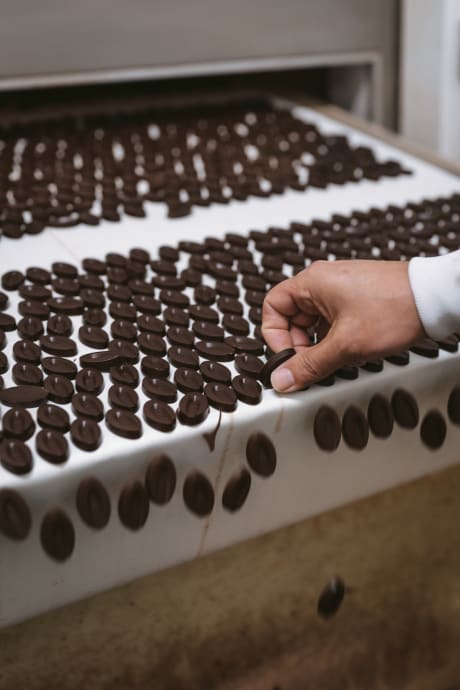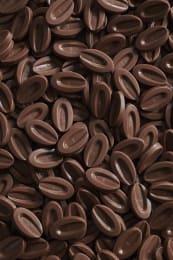Tackling our energy and water use
Acting against global warming
We currently own two chocolate factories: The Dodet site on the outskirts of Tain l’Hermitage and the historic Guironnet site in the town center. Our environmental plan covers these sites, as well as L’École Valrhona, our boutique, and the Cité du Chocolat. We closely monitor our energy usage in each of these different facilities. We are pursuing two key strategies to reduce our environmental impact. One is cutting down our carbon footprint; the other is reducing our energy consumption, while also promoting alternative energy sources.

Both sites at Tain l’Hermitage have had ISO 50001 certification since 2015. This acts as a guarantee that each will manage its energy use efficiently. To improve our energy consumption management, in 2017 we installed a new energy monitoring tool based on data mining technology with help from our partner Métron. This makes it easier to control our energy usage and identify where optimization is needed. Our work in this area covers every one of our major energy expenditures and is guided by our long-term energy plan.
Since 2013, we have reduced our total energy consumption by 40%, and 68% of our energy mix comes from renewable sources.
As part of our efforts to be an exemplary manufacturer in terms of energy consumption, we are proud to say that for the past five years, 100% of our electricity has come from certified purchases of hydroelectric power. Through these energy purchases under Guarantee of Origin Certificates, we help finance the renewable energy sector.
Looking towards 2025, our objective is twofold.
- A 50% reduction in our energy consumption as compared with 2013
- 79% of our energy mix to come from renewables
Storage of raw ingredients
In 2021, we invested in a new Cooling Unit that can produce heat in our raw ingredients storage area and an administrative building.
In return, it allows us to add cold air to our production workshop cooling loop. This brand-new Unit operates using a gas that has no impact on global warming. Our Dodet site therefore now operates without HCFC fluids (a fluorinated gas), which contribute very significantly to global warming. This unit is also more energy efficient and allows us to save around €12,000 per year.

More environmentally-friendly refrigeration systems.
Valrhona has to use refrigeration chambers in certain areas of its storage facilities to preserve the flavor qualities of these chocolate products. Hydrofluorocarbons (HFCs) are the fluids most commonly used in refrigeration and air conditioning systems. Their global warming potential is much higher than that of natural hydrocarbons or ammonia-based refrigerants. By investing in facilities that use low-warming fluids, Valrhona reduces their contribution to GHG emissions in the long term.
Our water management
In addition to measuring its carbon footprint, Valrhona also works to respect the planet’s limits. Water management is crucial to preserving the water resources that are essential to life on Earth.
Valrhona gets its water for industrial purposes from two key sources: municipal water which is mainly used for cleaning and well water which is used for industrial processes.
Water Consumption 2023
We aim to reduce by 2025 our water consumption by 50% compared to 2013 and to reduce water pollution caused by manufacturing processes.
By 2023, water consumption at the Tain l’Hermitage production sites had been reduced by 33% compared with 2013. This measure is highly dependent on summer heat in production plants, where temperatures have to be kept stable.
In addition to making employees more aware of their individual usage, teams worked on the risks of leaks in water circulation systems. The most important activity in 2023 was therefore to improve the metering system. This meant: 10 new water meters have been installed so that any leaks can be identified and repaired.
Air flotation
In 2023, the company invested in water treatment using an air flotation system. The aim is to prevent all discharges of fats into the mains water treatment system.
What is air flotation?
This is an industrial technique for removing organic waste from water. It purifies water by passing microbubbles of air into the water being treated, to which suspended particles attach themselves and rise to the surface as scum or foam. This scum can then be removed and impurities are eliminated from the water.
It is an effective method for removing a wide variety of contaminants, including suspended particles, oils and greases, heavy metals, and other undesirable substances.
In a nutshell, air flotation is a water purification process that uses microbubbles of air to remove impurities and suspended particles, helping to produce clean, safe water for a variety of uses.
The transition from theory to practice is proving more complex than expected, because the teams know that the treatment can be optimized and are working closely to this end with two external experts in the area. The company is constantly striving to adapt and improve, making “water”, this precious resource, a primary concern.


